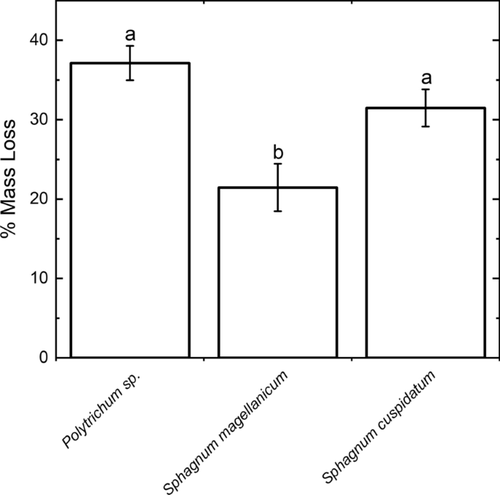Biogeochemistry ( IF 4 ) Pub Date : 2024-04-10 , DOI: 10.1007/s10533-024-01134-2 Lauren Bryan , Rachel Shaw , Erik Schoonover , Alexis Koehl , Suzanne DeVries-Zimmerman , Michael Philben

|
The unique pectin-like carbohydrate “sphagnan” has been shown to protect organic matter from microbial decomposition in Sphagnum-dominated peatlands. However, the bioavailability of sphagnan has not been evaluated, and it is not known if it persists or continues to affect decomposition processes over the long timescales of peat formation. To address this, we assessed the connection between sphagnan content and organic matter decomposition rates in a temperate peatland near Fennville, MI, USA. We compared the effects of sphagnan over two timescales: (1) a short-term litter incubation assay using mosses from different peatland microtopographies; and (2) oxic and anoxic incubation assays of peat collected from multiple depths within the peat profile, reflecting a natural long-term decomposition continuum. On both timescales, we hypothesized that higher sphagnan content would be associated with lower decomposition rates, and that sphagnan would be selectively preserved compared to bulk C and other carbohydrates. The litter decomposition experiment supported both hypotheses, as higher sphagnan content was associated with lower mass loss, and sphagnan content increased due to selective preservation. In the peat, we observed weak but significant correlations between the relative abundance of sphagnan (as a fraction of total non-cellulosic sugars) and both aerobic and anaerobic respiration rates. This relationship was stronger in cores collected from hollow microtopographies than those from hummocks. However, there was not a significant relationship between respiration rates and the total (C-normalized) sphagnan content. Sphagnan content increased with depth in the peat profile, indicating selective preservation compared to bulk C. Additionally, we observed the accumulation of non-cellulosic glucose in the deep peat, likely derived from microbial exopolysaccharides. Together, these results indicate that sphagnan persists in the catotelm and continues to contribute to the long-term stabilization of organic matter in Sphagnum-rich peatlands, although the weak relationship with respiration indicates that its influence is relatively minor.
中文翻译:

以泥炭藓为主的泥炭地中的泥炭藓:生物利用度及其对有机质稳定的影响
在以泥炭藓为主的泥炭地中,独特的果胶状碳水化合物“泥炭藓”已被证明可以保护有机物免受微生物分解。然而,泥炭藓的生物利用度尚未得到评估,并且不知道它是否持续存在或继续影响泥炭形成的长时间尺度的分解过程。为了解决这个问题,我们评估了美国密歇根州芬维尔附近的温带泥炭地的泥炭藓含量和有机物分解率之间的联系。我们比较了泥炭藓在两个时间尺度上的影响:(1)使用来自不同泥炭地微地形的苔藓进行短期垫料孵化测定; (2) 对从泥炭剖面内多个深度收集的泥炭进行有氧和缺氧培养分析,反映了自然的长期分解连续体。在这两个时间尺度上,我们假设较高的水苔聚糖含量与较低的分解率相关,并且与大量碳和其他碳水化合物相比,水苔聚糖将被选择性地保存。凋落物分解实验支持了这两种假设,因为较高的水苔素含量与较低的质量损失相关,并且由于选择性保存而增加了水苔素含量。在泥炭中,我们观察到泥炭藓的相对丰度(作为总非纤维素糖的一部分)与有氧和无氧呼吸速率之间存在微弱但显着的相关性。从空心微地形收集的岩心中,这种关系比从山丘中收集的岩心更强。然而,呼吸速率与水苔聚糖总含量(C-归一化)之间不存在显着关系。泥炭藓含量随泥炭深度的增加而增加,表明与散装碳相比具有选择性保存。此外,我们观察到深层泥炭中非纤维素葡萄糖的积累,可能源自微生物胞外多糖。总之,这些结果表明,泥炭藓持续存在于泥炭土中,并继续有助于富含泥炭藓泥炭地有机质的长期稳定,尽管与呼吸的弱关系表明其影响相对较小。



























 京公网安备 11010802027423号
京公网安备 11010802027423号